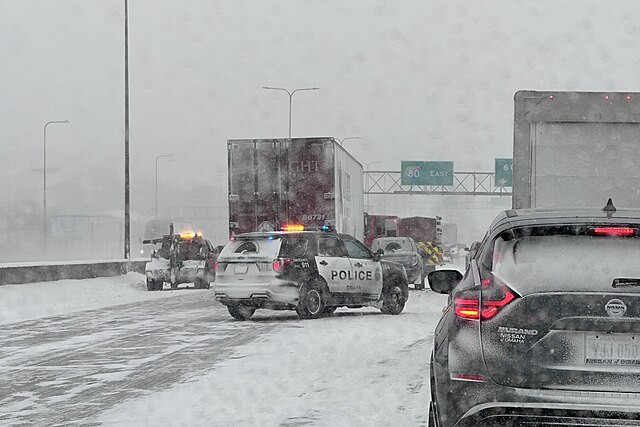More than 100 million Americans are bracing for severe winter weather this week as two major storms move across the country, bringing snow, ice, and frigid temperatures to the Midwest and East Coast, while California faces the threat of a significant atmospheric river event.
The first storm is expected to begin Monday night, with snowfall accumulating in cities such as Kansas City, Missouri, before pushing eastward into Tuesday and Wednesday. The National Weather Service (NWS) has issued winter storm warnings and watches for 23 states, warning of hazardous conditions that could disrupt travel and cause power outages.
"A series of storm systems will impact the region into next week. They will come in the form of measurable wintry mixes (Monday night through Tuesday night) and locally heavy, potentially flooding, rainfall (Tuesday night through Wednesday night)," NWS Blacksburg, Virginia, posted on X, formerly Twitter.
Winter Storm Warnings in Multiple States
The NWS issued winter storm warnings for Virginia and West Virginia, signaling that dangerous winter weather is either occurring or imminent. Additionally, winter storm watches were declared for parts of Indiana, Nebraska, New Jersey, Maryland, Delaware, Kansas, and Missouri, as well as portions of Colorado, Iowa, and Illinois.
Winter weather advisories were also in effect for Ohio and New York, while extreme cold warnings covered northern Montana and North Dakota, where wind chills could reach as low as minus 50 degrees Fahrenheit. The NWS warned that "dangerously cold" conditions could result in frostbite on exposed skin in as little as 10 minutes.
Arctic Air and Heavy Snowfall in the Midwest
Forecasters expect up to 10 inches of snowfall in isolated parts of northern Michigan's Houghton County, with blowing snow potentially reducing visibility. The NWS Great Falls, Montana, warned on Sunday: "Arctic air will impact all of Montana Monday through Tuesday with another push of Arctic air later this week. Low temperatures Monday night/Tuesday morning will be the coldest temperatures of the year across much of Montana."
Cold weather advisories have been issued for states including California, Oregon, Washington, Montana, Minnesota, Wisconsin, North Dakota, and South Dakota, indicating frigid wind chills that pose risks to infants, elderly individuals, and those without adequate shelter.
Southern California Faces Heavy Rain and Flood Risk
While the Midwest and East contend with snow and ice, the West Coast is preparing for a significant atmospheric river event that could bring torrential rainfall to California. Meteorologists warn that Los Angeles and other Southern California regions could face three days of heavy rain starting late Wednesday, increasing the risk of flooding and mudslides.
"Major atmospheric river event for California coming this Thursday," meteorologist Ryan Maue posted on X. "Widespread 2-4 inches of rainfall even in SoCal. A bit colder system so mountain snows (Sierra) should be exceptional-maybe 4-6 feet."
The National Weather Service office in Los Angeles noted that "much uncertainty" remains regarding the timing and intensity of the system, but heavy precipitation is highly likely. The Sierra Nevada is expected to receive multiple feet of snow, creating dangerous travel conditions in higher elevations.
Travel Disruptions and Infrastructure Risks
With snow, ice, and flooding threats spanning the nation, forecasters warn of major travel disruptions. The NWS has cautioned that roads could become treacherous due to ice accumulation, while reduced visibility from blowing snow may further complicate travel.
Authorities are also monitoring the risk of power outages, particularly in areas where ice accumulation on power lines could cause widespread electrical failures. Additionally, in regions facing extreme cold, frozen pipes and heating system failures could pose additional challenges.
What's Next?
At the time of writing, winter weather advisories remain in effect until 7 p.m. Monday, while winter storm warnings are expected to persist through Wednesday. Cold weather advisories, particularly in the western states, are set to last until at least Thursday afternoon.






